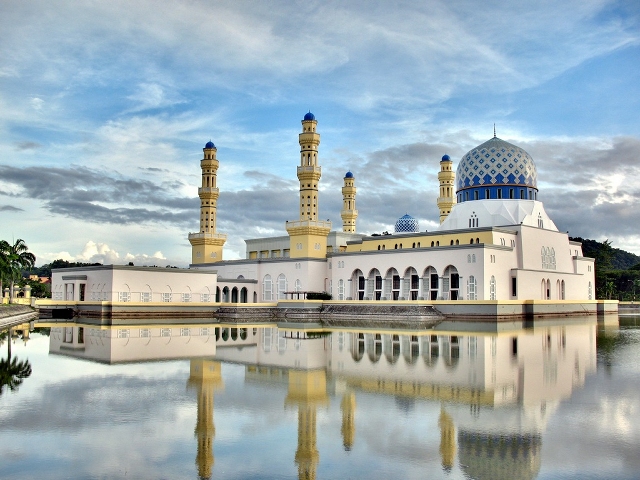The Omar Ali Saifuddien Mosque is dominates the city centre of Bandar Seri Begawan. It is one of the most magnificent mosques of South-East Asia, and a symbol of the strong Islamic faith of the people of Brunei.

The mosque was completed in 1958 and is named after the 28th Sultan, Omar Ali Saifuddien, who is still referred to as the architect of modern Brunei. The mosque’s design reflects the use of the world’s most elegant materials, including marble from Italy, granite from Shanghai, stained glass and chandeliers from England and carpets from Belgium and Saudi Arabia.
Located in a lagoon beside the mosque is a replica of a 16th Century mahligai barge, which was used to stage colourful religious ceremonies such as the Koran reading competitions during the 1960s and early 1970s. You will be required to remove your shoes prior to entering the mosque, and you should also be dressed conservatively.
The mosque is closed to non-muslims on Thursday. Access is restricted to late afternoon on Fridays.
The Jame’ Asr Hassanal Bolkiah Mosque is another magnificent in Brunei Darussalam and a symbol of Islam’s firm hold in the country during His Majesty’s reign. It is situated in the Kampong Kiarong, a few kilometres from the capital.
It was built to commemorate the 25th anniversary of His Majesty the Sultan’s reign, this mosque is the largest and arguably the most magnificent in Brunei. With its intricately ornamented minarets and shimmering golden domes dearly visible along the main route into town from the airport, the Kiarong Mosque (as it is locally known) towers over a landscaped terrain dotted with fountains.
The Sabah State Mosque is resplendent structure, with its majestic domes and gold inlay motifs, is a spectacular sight. More important, it is ideally located as a place of worship for Kota Kinabalu’s Muslim inhabitants and visitors.
The Sikh Temple was built by a local Sikh philanthropist in 1998 and reputedly one of the largest in Malaysia. The architecture was inspired by the Sikh “Golden Temple” in Amritsar. It offers people in need free accommodation at the temple hostel.
Before entering, visitors are required to cover their heads with a piece of cloth as a sign of respect.
The An’Nur Jamek Mosque is featuring futuristic architecture, is the pride of Labuan’s Muslim and symbolises the progressive spirit of the people and island of Labuan. Built at a cost of US$11 million, the majestic An’Nur Jamek Mosque is the pride of Labuan’s Muslim community.
The Kuching State Mosque is one of the city’s most important landmarks, with its idyllic riverside location and its multiple gilded cupolas. Although a relatively modern building (1968), its design is faithful to traditional Islamic architecture. It is set in an ancient Muslim cemetery on the site of an old wooden mosque. The mosque and its grounds are open to visitors, but they are asked to dress respectfully and to not enter the mosque during prayer times. The Kuching Mosque previously functioned as the State Mosque but this role has now been taken over by the splendid new State Mosque across the river at Petra Jaya, which has an unusual modern single cupola design. Another interesting mosque can be found in Gambier Street. It is completely hidden away by rows of shophouses. This mosque originally served the Indian Muslim community in Kuching and is the oldest in the city.
 Places of Worships? Please Vote!
Places of Worships? Please Vote!


